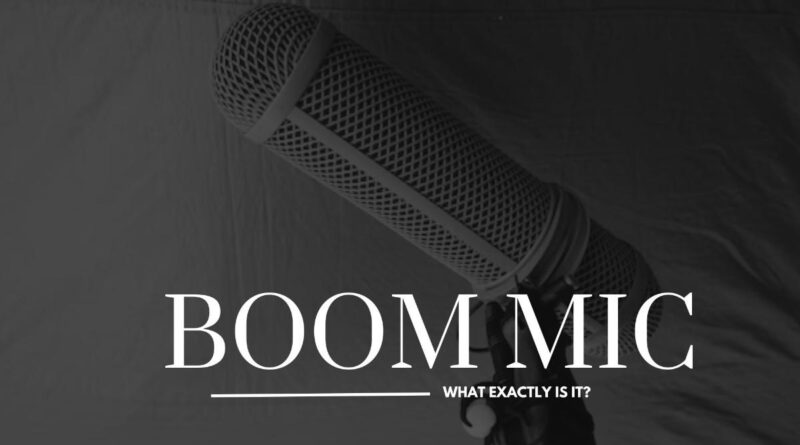What Is A Boom Mic? (Types, Benefits & More)
Have you ever thought about how they get clear sound in movies and TV shows, even when there’s a lot happening on screen or actors are talking? Well, one important thing they use is called a boom mic. It’s a special microphone that helps record sound really well. Let’s take a closer look at what a boom mic is and how it makes sure the audio in movies and shows sounds great.
What Is A Boom Mic?
A boom mic, short for boom microphone, is a specialized type of microphone commonly used in film, television, and video production to capture high-quality audio. Unlike traditional microphones that are mounted on stands or clipped onto clothing, boom mics are typically mounted on a boom pole—a long, lightweight pole that allows the mic to be positioned close to the sound source without appearing in the frame of the shot.
Why Boom Mics Are Used?
Boom mics are favored in audio recording for several reasons. Firstly, their elevated position allows them to capture sound from a more natural and unobtrusive angle, avoiding the need for bulky equipment visible in the shot. Additionally, boom mics offer greater flexibility in capturing audio from various distances and angles, making them ideal for capturing dialogue and ambient sounds in dynamic filming environments.
Components Of A Boom Mic
A typical boom mic consists of several key components:
- Microphone Element: The core component responsible for capturing sound.
- Shock Mount: A suspension system that isolates the microphone from handling noise and vibrations, ensuring clean audio.
- Boom Pole: A lightweight, extendable pole that allows the operator to position the microphone precisely.
- XLR Cable: A balanced audio cable that connects the microphone to the recording device.
- Windscreen/Deadcat: A foam cover or furry windshield that minimizes wind noise and other unwanted environmental sounds.
How Boom Mics Work?
Boom mics operate on the principle of capturing sound waves and converting them into electrical signals, which are then transmitted to a recording device. The microphone element within the boom mic contains a diaphragm that vibrates in response to sound waves, generating electrical signals proportional to the sound pressure variations. These signals are then amplified and recorded for later processing.
Types Of Boom Mics
Boom mics come in various types, each suited to different recording scenarios:
- Shotgun Microphones: These highly directional microphones have a narrow pickup pattern, allowing them to capture sound from a specific direction while rejecting ambient noise from other directions. Shotgun mics are ideal for capturing dialogue in noisy or crowded environments.
- Lavalier Microphones: Also known as lapel mics, lavalier microphones are small, discreet microphones that can be clipped onto clothing. While not typically used on a boom pole, lavalier mics offer hands-free operation and are commonly used in interviews and live presentations.
- Parabolic Microphones: Parabolic microphones feature a dish-shaped reflector that focuses sound waves onto a microphone element placed at the dish’s focal point. These mics are often used in sports broadcasting and wildlife recording to capture distant sounds with exceptional clarity.
- Boundary Microphones: Also known as PZM (Pressure Zone Microphones), boundary microphones are designed to be placed on a surface, such as a table or wall, to capture sound reflections. While not typically used on a boom pole, boundary mics offer omnidirectional pickup and are commonly used in conference rooms and stage productions.
How To Set Up A Boom Mic?
Setting up a boom mic involves attaching the microphone to a pole and positioning it for optimal audio capture. Here’s a general guide:
Equipment:
- Boompole
- Microphone (usually a shotgun mic)
- Shock mount (isolates mic from vibrations)
- XLR cable (if using a non-USB microphone)
- Mic windscreen (reduces wind noise) – optional
Steps:
- Attach the Shock Mount: Most shotgun mics come with a screw-on shock mount. Follow the microphone’s instructions to secure it.
- Mount the Microphone on the Boompole: Slide the shock mount with the microphone onto the boom pole and tighten the attachment screw.
- Attach the Cable (XLR mics only): XLR mics require an XLR cable to connect to your recording device (camera, audio recorder). Connect one end of the XLR cable to the microphone and the other to your recorder.
Positioning the Boom Mic:
- Adjust the Boom Pole Length: Extend the boom pole to position the microphone just above the sound source (usually the speaker’s mouth). Aim for a distance of 6 to 12 inches.
- Mic Aiming: The microphone should point directly at the sound source. Avoid angling it towards your clothing or other objects that could create rustle or unwanted noise.
- Minimize Cable Noise: For XLR mics, manage the cable to avoid rubbing against the boom pole or creating any noise that might be picked up by the microphone. Some boom poles have internal channels for cables.
- Wind Protection (optional): If using outdoors in windy conditions, slip on a windscreen over the microphone to reduce wind noise.
Additional Tips:
- Practice Boom Mic Handling: To avoid unwanted bumps or vibrations in the recording, practice smooth movements with the boom pole.
- Cable Management: Secure any excess cable with velcro straps or cable ties to prevent tripping hazards.
- Monitor Audio Levels: While recording, use headphones to monitor the audio levels and ensure the speaker’s voice is clear and not distorted.
What Does A Boom Mic Plug Into?
Boom mics, those trusty audio companions on film sets and stages, rely on specific connectors to transmit their captured sound. Here’s a breakdown of what a boom mic typically plugs into:
-
XLR Connector
The most common connection for professional boom mics is the XLR connector. It has three pins for separate signal and ground transmission, ensuring a reliable and balanced audio connection. XLR connectors are found on:
- Audio Recorders: Portable recorders or field recorders used for location sound capture often have XLR inputs for boom mics.
- Mixer Preamps: In larger productions, the boom mic might connect to a mixer preamp, which enhances the microphone’s signal before feeding it into the main sound system.
-
Wireless Transmitters
For more freedom of movement, boom mics can be equipped with a wireless transmitter. This tiny pack plugs directly into the microphone’s output and transmits the audio signal to a receiver connected to the recording device.
-
Mic Jacks on Cameras (Less Common)
Some modern cameras, especially higher-end models, have built-in microphone jacks. While not ideal for professional use due to limited control and lower audio quality, a boom mic with a compatible jack can be a handy option for basic videography.
-
Adapters for Flexibility
The world of audio connections can get diverse. Luckily, adapters exist to bridge the gap. For instance, you might find an XLR-to-1/4″ jack adapter if your camera only has a standard mic jack.
Advantages Of Using A Boom Mic
- Superior Sound Quality: Boom mics are often high-quality condenser microphones that can capture sound with more detail and clarity than built-in mics. They can also be positioned closer to the sound source, which improves audio quality through the proximity effect (boosting low frequencies for a richer sound).
- Isolation from Background Noise: Boom mics are frequently directional, meaning they pick up sound from a specific area in front of the microphone. This helps to reduce unwanted background noise and focuses on the desired audio.
- Flexibility and Control: The magic of the boom pole allows the microphone to be positioned exactly where it’s needed. This is crucial for film and video production where the mic needs to be out of the shot while capturing clear dialogue. Boom mics are also useful for capturing specific sounds or ambient noise in a scene.
- Versatility: Boom mics can be used in various scenarios, including filmmaking, television production, live events, podcasting, and even capturing high-quality audio for presentations or lectures.
Limitations Of Boom Mics
Despite their many advantages, boom mics also have some limitations that users should be aware of:
- Operating a boom pole for extended periods can be physically demanding, requiring strength and endurance, especially when holding the mic steady for long takes.
- Outdoor recording sessions can be challenging due to wind noise, which can degrade audio quality. Wind protection accessories such as deadcats or blimps help mitigate this issue but may not eliminate it entirely.
- While boom mics are designed to stay out of the frame, there is always a risk of the microphone or boom pole accidentally appearing in the shot, especially in tight or complex camera setups.
- Boom mics have a limited range and may struggle to capture distant sounds or whispers, requiring careful positioning and adjustment by the operator.
Tips For Using A Boom Mic Effectively
- Positioning: Proper microphone placement is crucial for capturing clean, clear audio. Position the boom mic close to the sound source while remaining out of the frame, adjusting the angle as needed to capture optimal sound.
- Monitoring: Use headphones to monitor audio levels during recording sessions, ensuring that sound is captured at the desired volume without clipping or distortion.
- Wind Protection: In outdoor settings, use wind protection accessories such as deadcats or blimps to minimize wind noise and ensure clean audio recordings.
- Boom Operator Communication: Establish clear communication between the boom operator and other members of the production team, including the director and sound mixer, to coordinate movements and ensure smooth audio capture.
- Practice: Like any skill, operating a boom mic effectively requires practice and experience. Familiarize yourself with the equipment and techniques through hands-on practice and experimentation.
What Is A Boom Mic Stand?
A boom mic stand is basically a regular microphone stand with an added feature: a horizontal arm called a boom. This boom extends outward from the vertical pole of the stand, allowing you more flexibility in positioning your microphone.
Here’s why boom mic stands are useful:
- They can position the microphone over or around objects that would otherwise be in the way of a straight stand. For instance, you can use a boom stand to mic a guitar or drum kit without the vertical pole getting in the way.
- They allow for more precise microphone placement. You can adjust the boom’s angle and distance to get the microphone in the perfect spot to capture the sound you want.
Boom arms come in different varieties:
- Fixed length booms offer a set reach.
- Adjustable (telescoping) booms allow you to extend the arm to different lengths for even more flexibility.
Conclusion
A boom mic is a microphone mounted on a long pole, often used in film and television production. It captures sound from a distance while staying out of the shot, thanks to the skilled work of a boom operator. Boom mics are particularly useful for recording clear dialogue and interviews, as they can focus on the desired sound source and minimize background noise. Whether you’re a budding filmmaker or simply curious about audio equipment, understanding the role of the boom mic is a valuable step.
Frequently Asked Questions
Can I use a boom mic with my smartphone?
There are compact shotgun microphones designed for smartphones that can be attached to a short tripod or selfie stick, offering a step-up in audio quality over the built-in mic. However, a full-fledged boom mic setup with a long pole is impractical for mobile use.
What are some alternatives to boom mics?
For situations where a boom mic is cumbersome, lavalier microphones (lav mics) are a popular option. These small mics clip directly onto the speaker’s clothing and provide a discreet way to capture audio. However, lav mics can pick up clothing rustle and require careful placement to avoid plosives (exaggerated “p” and “b” sounds).
Do I need a professional boom operator to use a boom mic?
While professional productions employ dedicated boom operators to precisely position the mic throughout filming, a basic understanding of microphone placement and techniques can allow you to use a boom mic effectively for personal projects. Practice smooth mic movements and maintaining it out of the camera’s frame.
Are boom mics always directional?
The most common type of microphone used on a boom pole is a shotgun microphone, which has a tight pickup pattern focusing on the area directly in front of it. However, in some situations, omnidirectional microphones might be used on a boom pole if capturing the entire soundscape of a scene is desired.
How can I improve the sound quality of my boom mic recordings?
Wind noise can be a significant issue with boom mic recordings outdoors. Consider using a windscreen, a furry cover that reduces wind interference without affecting the desired audio. Additionally, pay attention to background noise during filming. If possible, try to minimize distracting sounds or choose quieter locations.




